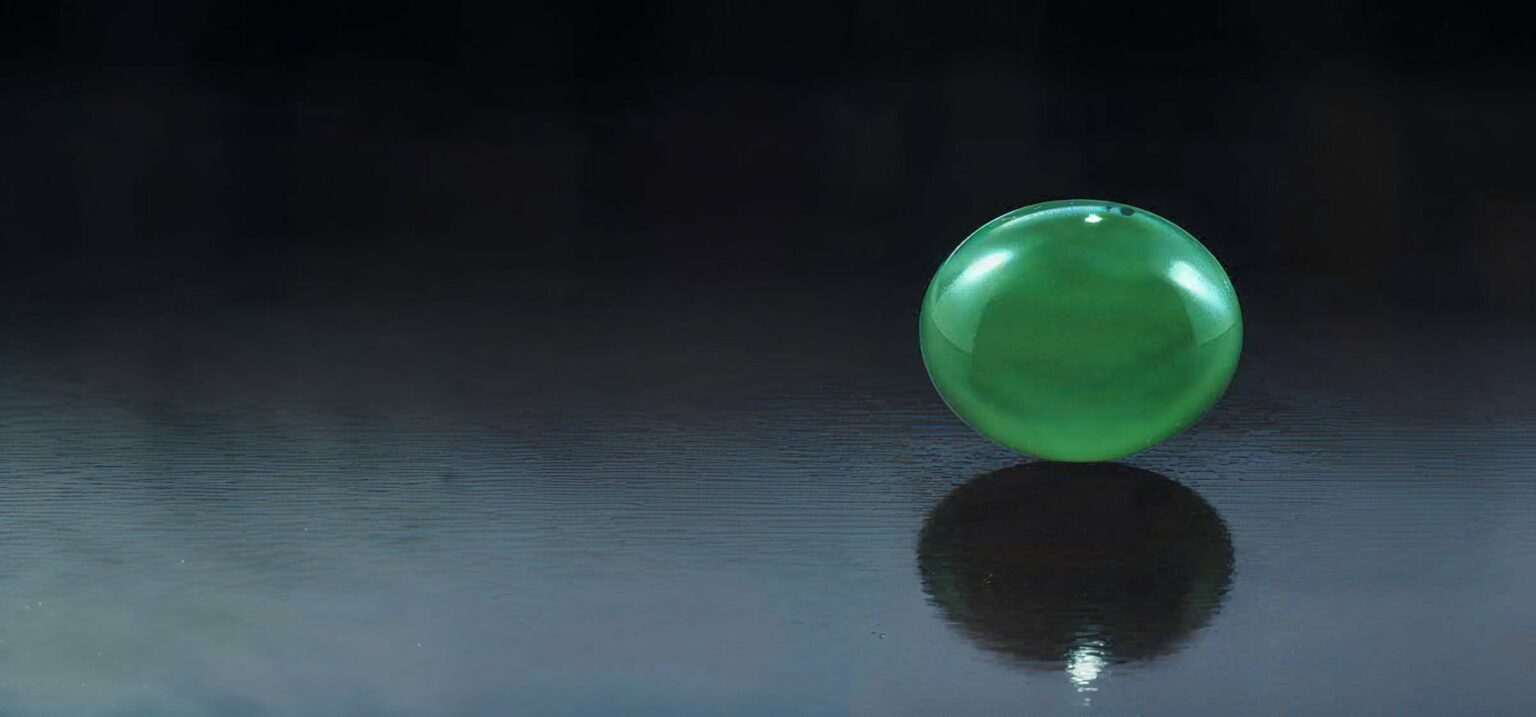Although quaint folklore and superstition heighten consumer interest in stones like sapphire and opal, they rarely clinch sales of these gems. But when it comes to jadeite, folklore and superstition are living reality and, thus, bona fide selling points.
In fact, jadeite may be the world’s only gemstone that is still used as much for an amulet as it is for adornment. It is estimated that millions of Orientals, Chinese especially, wear jadeite jewelry for good luck and health.
“Within every Oriental there lurks a jade lover,” says jadeite specialist Leon Mason, Mason/Kay Inc., Los Angeles. That love has yet to surface in the West. Except for a relative handful of connoisseurs (most of them dealers), jadeite is widely misunderstood and little appreciated in Europe and America.
But to an increasing more Western dealers, jadeite has become as obsessive as it has long been for dealers in places like Thailand and Hong Kong. It’s easy to see why.
A Cultural Mainstay
Jade is most intimately identified with China where it has been used for 5,000 years. For centuries, poets there linked its virtues to those of the gods. Even Confucius praised its virtues.
Ironically, the jade of antiquity which the Chinese once prized is not jadeite. It is a sister jade called nephrite. But this “diaphanous, white nephrite is no longer available,” cautions Don Kay of Mason/Kay, “and bears no resemblance to the dull wax green nephrite most commonly found today.”
Sometime in the 18th century, Burmese jadeite was introduced into China. It was called “te t’sui,” which means “kingfisher feather,” because its intense spectral green conjured up the color intensity of that bird’s feathers (which, in actuality, are blue). This green, coupled with the stone’s luster and translucence, captivated Chinese carvers and artisans. Ever since, jadeite has been the jade of preference worldwide. Indeed, nephrite is valued mainly for its antiquity while jadeite is valued in and of itself.
A case in point: Around 1965, New York gem dealer Marty Harman, Martin I. Harman Inc., bought an antique jadeite Chinese archer’s ring for $735. After he had it cut into four cabochons, he fetched $10,000 for the stones. “That piece was worth ten times more when cut into cabs left as an antique,” Harman says.
That anecdote gives some idea of the tremendous value placed on fine jadeite. As a result, Chinese dealers will gamble tens, even hundreds of thousands of dollars on jadeite rough (called “boulders”—weighing anywhere from kilograms to hundreds of pounds, that they think will yield superb stones. The Chinese—for whom high-stakes gambling is second nature, will occasionally buy a rough based only on its outward appearance. “Surface flecks or stripes of green may embolden them to bid on a boulder,” says Richard Postel, Gem Source Ltd., Bay Harbor, Fla., who buys jadeite in both Burma and Thailand.
More often, he continues, the Chinese will buy based on evaluation of the rough after a small window has been polished on its surface. “That gives more of an indication of the quality one can expect,” Postel says, “but the risks are still enormous.”
Although Burma is the sole source of fine jadeite and Thailand its prime entry point (via smugglers) into the jewelry world, Hong Kong is the gem center most associated with jadeite—indeed, all jade—today.
According to Mason, Hong Kong dealers have very definite priorities when cutting jade rough. If a piece is free of streaks and fractures, and deep enough, it is earmarked for cutting into cabochons—easily the most desirable form of jadeite. Next come, in descending order, bangles, beads, carvings and discs (also known as “doughnuts”).
From a standpoint of volume, jadeite is most often cut into carvings, including quite often, Buddhas, animals and crosses. Since jadeite has enduring use as a talisman, these carvings prove extremely popular, especially in small pendant form.
Quality in Jadeite
Jadeite comes in many colors (including lavender and red), but green is the color in which it is most coveted. Experts describe the ideal for this color in varying ways. Harmon likens the finest green in jadeite to that of liquid Prell concentrate. Kay compares that color to “the intense green shoots of a freshly seeded lawn.” In gem terms, the ideal is describe as “emerald green.” Stones that exhibit forest or spinach green are considered too dark; stones paler than a pleasing apple-green are too light.
But quality in jadeite isn’t merely a matter of hue and tone. It is a function of several factors, described by Los Angeles dealer George Dobbs, Van Dobbs Ltd., as follows:
Color Uniformity: Stones should be free of blotchiness that imparts an unevenness to the color.
Translucency: Stones should be semi-transparent in natural light.
Clarity: Stones should be as inclusion-free as possible when illuminated from beneath by a fiber-optics or penlight source.
Brightness: Stones should exhibit a lustrous brilliance that some dealers describe as a glow.
When all these factors—hue, color uniformity, translucency, clarity and brightness—are present to a high degree, prices for jadeite cabs will be in excess of $10,000 per piece (jadeite is rarely priced by the carat). Several dealers quoted prices for “gem-quality” stones between $10,000 to as a $50,000 per piece, larger stones double that and more.
Closer-to-earth commercial jadeite cabochons acceptable for both women’s and men’s jewelry (jadeite is extremely tough and durable) begin around $200 and quickly climb to the $1,000-$2,000 range per piece. Expect such stones to be near opaque to nearly translucent, lighter or darker green and included. Also, such stones often will not exhibit the high polish associated with better jadeite. Around $5,000 per piece, jewelers can begin to find nice apple-green stones with good translucency, clarity and brightness. But it isn’t until one reaches the $10,000 mark that stones start to be designated as truly fine.
One last word about buying jadeite. Ask suppliers if it is dyed (a common problem with jade) and make sure they guarantee it as not treated. “Any worthwhile dealer will do so,” Dobbs says.
Please note: this profile was originally published in 1988 in Modern Jeweler’s ‘Gem Profiles: The First 60’, written by David Federman with photographs by Tino Hammid.
The 9.47-carat Burma jadeite shown in the header image is courtesy of American Jade N Gem Corp., Los Angeles.




